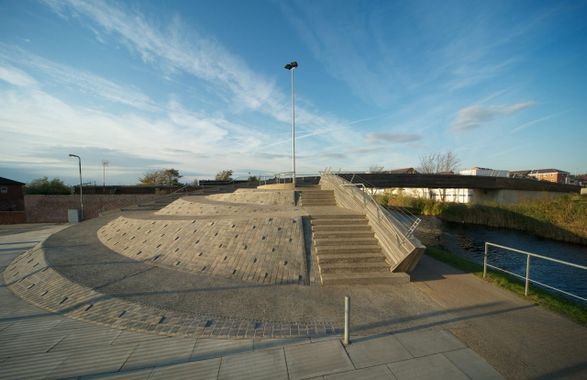
Pennington Road Footbridge
ARCHITECTS
Softroom
LOCATION
Merseyside, UK
CATEGORY
Pedestrian Bridge
STRUCTURAL ENGINEERING
Eckersley O’Callaghan
PHOTOGRAPHS
Joseph Burns
PROJECT YEAR
2011
INTRODUCTION
Softroom Architects and Eckersley O’Callaghan structural engineers won the commission for the Pennington Road footbridge through an RIBA design competition in 2006/7 that attracted over 150 entries from around the world. Replacing an old industrial structure, the recently completed bridge is intended to act as a focus for the regeneration of the area and a gateway to Bootle for users of the Leeds-Liverpool canal.
THE BRIDGE AND APPROACHES
The overall bridge form follows a typology of traditional canal bridges, where a ramped side approach links to a simple spanning or shallow arched bridge structure.
Updated for current standards of accessibility, the steep ramp has been replaced with a more complex shallow inclined and stepped approach, and gently curving approaches have been cut into a newly formed hard landscape, much as paths wind their way up a hillside slope.
BRIDGE STRUCTURE
The bridge span is 19.4 metres with a deck width of 2.4 metres. The structure is a pair of deep, rectangular, singly curved, mechanically laminated and simply supported hardwood beams placed within the balustrade zone of the bridge in order to reduce the depth of the structure.
This provides a visually unobtrusive and elegant design solution. Cantilevered reinforced concrete abutments span over the towpath, supported by faceted concrete in-situ concrete walls, these in turn supported on cast in-place piles. The ramp structure is of reinforced earth, sitting on a basal layer of reinforced fill supported by piles.
MATERIALITY AND SUSTAINABILITY
The bridge structure and finishes are constructed from timber to create a feeling of tactility and warmth. The specification of a sustainably sourced hardwood provides longevity and robustness to the design as well as addressing concerns about sustainable construction.
The timber is mechanically laminated with steel dowels and bolts, avoiding the use of adhesives.
The concrete works utilise a pulverised fuel ash as a more sustainable substitute to cement, and reinforced earth engineering techniques have been employed to support the curving ramp structure to minimise the requirement for using additional concrete.
ACCESSABILITY
The bridge is designed to be fully accessible, safe and enjoyable to use by all with gentle generous approaches and level thresholds throughout. The design also promotes the sense of a social landscape for the local community; the stepped and inclined approach to the west bank and the generous width and welcoming materiality of the bridge and approach to the east offer places to dwell and ponder, rest and interact. This improved condition creates a strong sense of place, and compliments the wider urban renewal ambitions of the adjacent housing developments.













